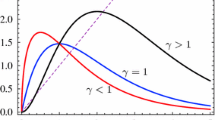Abstract
The concept of density-dependent population growth is fundamental to our understanding of how populations persist. While it is generally agreed that negative density dependence must occur at high densities, the direction of density dependence may be negative (pure negative density dependence) or positive (demographic Allee effect) at low densities. In this article, we present a technique to link the direction of density dependence to generic ecological factors. This technique involves exploiting the presence of a particular bifurcation, known as a saddle-node-transcritical interaction. We first provide a method to detect this bifurcation in a given model and then demonstrate its ecological relevance using several existing mechanistic models. With a mathematical framework in place, we are able to identify scenarios in which neither a weak Allee effect nor pure negative density dependence are possible. More generally, we find conditions on parameter values that are necessary for transitions between pure negative density dependence and demographic Allee effects to occur.






Similar content being viewed by others
References
Allee WC, Park O, Emerson AE, Park T, Schmidt KP et al (1949) Principles of animal ecology, vol 1. Saunders, Philadelphia
Angulo E, Roemer GW, Berec L, Gascoigne J, Courchamp F (2007) Double allee effects and extinction in the island fox. Conserv Biol 21(4):1082–1091
Berec L, Boukal D S (2004) Implications of mate search, mate choice and divorce rate for population dynamics of sexually reproducing species. Oikos 104(1):122–132
Berec L, Boukal DS, Berec M (2001) Linking the allee effect, sexual reproduction, and temperature-dependent sex determination via spatial dynamics. Am Nat 157(2):217–230
Berec L, Angulo E, Courchamp F (2007) Multiple Allee effects and population management. Trends Ecol Evol 22(4):185–191
Boukal DS, Berec L (2002) Single-species models of the Allee effect: extinction boundaries, sex ratios and mate encounters. J Theor Biol 218(3):375–394
Courchamp F, Berec L, Gascoigne J (2008) Allee effects in ecology and conservation. Oxford University Press, Oxford
Dennis B (1989) Allee effects: population growth, critical density, and the chance of extinction. Nat Resour Model 3(4):481–538
Dodds PS, Watts DJ (2005) A generalized model of social and biological contagion. J Theor Biol 232 (4):587–604
Donohue JG, Piiroinen PT (2017) Protective parenting may have population-level consequences. Ecol Complex 31:72–77
Gascoigne JC, Lipcius RN (2004) Allee effects driven by predation. J Appl Ecol 41:801–810
Gascoigne J, Berec L, Gregory S, Courchamp F (2009) Dangerously few liaisons: a review of mate-finding allee effects. Popul Ecol 51(3):355–372
Guckenheimer J, Holmes P (1983) Nonlinear oscillations, dynamical systems, and bifurcations of vector fields. Springer, New York
Kramer AM, Dennis B, Liebhold AM, Drake JM (2009) The evidence for Allee effects. Popul Ecol 51(3):341
Kuznetsov YA (2004) Elements of applied bifurcation theory, 3rd edn. Springer, New York
Lidicker WZ (2010) The Allee effect: its history and future importance. Open Ecol J 3:71–82
Murdoch WW, Walde SJ (1989). In: Grubb P J, Whittaker J B (eds) Analysis of insect population dynamics. Blackwell, Oxford, pp 113–140
Nicholson AJ (1933) The balance of animal populations. J Anim Ecol 2:132–178
Odum HT, Allee W (1954) A note on the stable point of populations showing both intraspecific cooperation and disoperation. Ecology 35(1):95–97
Pavlová V, Berec L, Boukal D (2010) Caught between two Allee effects: trade-off between reproduction and predation risk. J Theor Biol 264(3):787–798
Saputra KVI (2015) Dynamical systems with a codimension-one invariant manifold: the unfoldings and its bifurcations. Int J Bifurc Chaos 25(06):091
Saputra KVI, Van Veen L, Quispel GRW (2010) The saddle-node-transcritical bifurcation in a population model with constant rate harvesting. Discr Contin Dyn Syst Ser B 14:233–250
Schreiber SJ (2003) Allee effects, extinctions, and chaotic transients in simple population models. Theor Popul Biol 64(2):201–209
Stephens PA, Sutherland WJ (1999) Consequences of the Allee effect for behaviour, ecology and conservation. Trends Ecol Evol 14(10):401–405
Stephens PA, Sutherland WJ, Freckleton RP (1999) What is the Allee effect? Oikos 87:185–190
van Kooten T, de Roos AM, Persson L (2005) Bistability and an Allee effect as emergent consequences of stage-specific predation. J Theor Biol 237(1):67–74
Veit RR, Lewis MA (1996) Dispersal, population growth, and the allee effect: dynamics of the house finch invasion of eastern north America. Am Nat 148(2):255–274
Verhulst P (1838) Notice sur la loi que la population suit dans son accroissement. Corresp Math Phys 10:113–117
Volterra V (1938) Population growth, equilibria, and extinction under specified breeding conditions: a development and extension of the theory of the logistic curve. Hum Biol 10(1):1–11
Walter JA, Grayson KL, Johnson DM (2017) Variation in Allee effects: evidence, unknowns, and directions forward. Popul Ecol 59:1–9
Wells H, Strauss EG, Rutter MA, Wells PH (1998) Mate location, population growth and species extinction. Biol Conserv 86(3): 317–324
Funding
This publication has emanated from research conducted with the financial support of Science Foundation Ireland under the grant number SFI/13/IA/1923.
Author information
Authors and Affiliations
Corresponding author
Electronic supplementary material
Below is the link to the electronic supplementary material.
The following supplementary material is available for this article:
Section S1 Study of the normal form of the saddle-node-transcritical interaction
Section S1.1 Bifurcation structure when c > 0
Section S2 Discrete-time example
Section S3 Centre-manifold projection for emergent Allee effect model
Section S4 Evaluation of cubic terms at codimension-2 point
Rights and permissions
About this article
Cite this article
Donohue, J.G., Piiroinen, P.T. A technique for analysis of density dependence in population models. Theor Ecol 11, 465–477 (2018). https://doi.org/10.1007/s12080-018-0380-5
Received:
Accepted:
Published:
Issue Date:
DOI: https://doi.org/10.1007/s12080-018-0380-5




